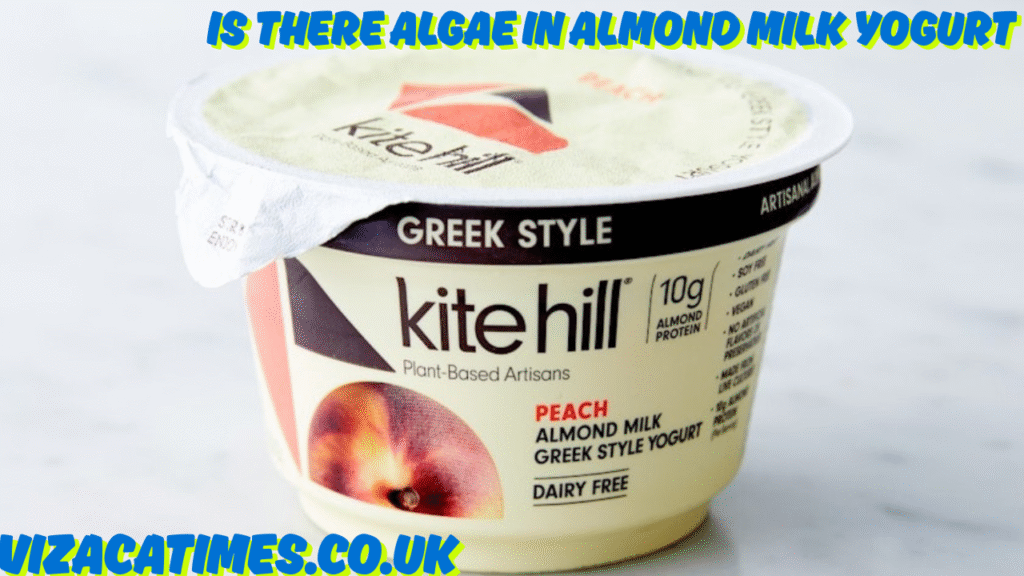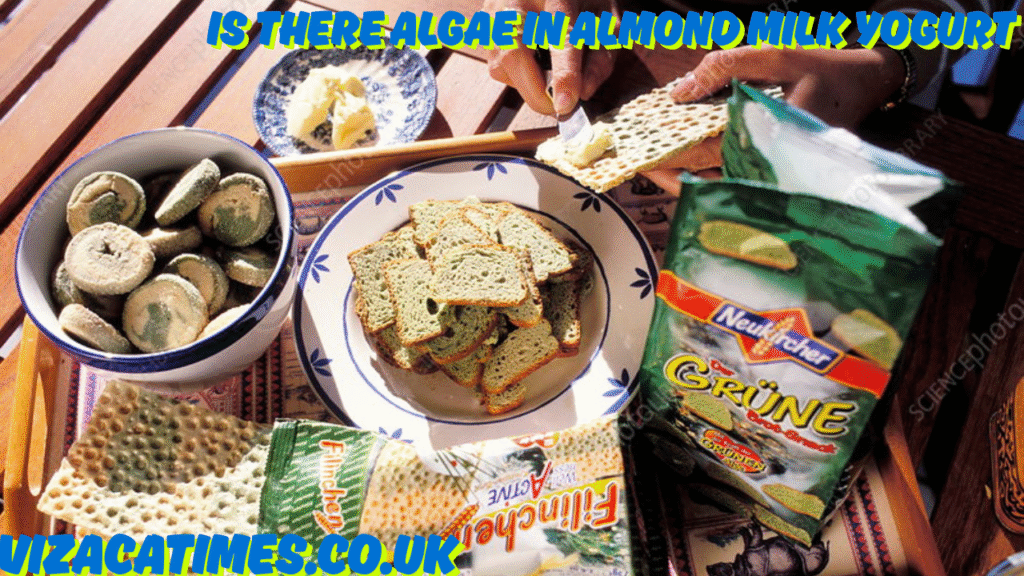Is There Algae in Almond Milk Yogurt?? Exploring the Truth Behind Ingredients, Nutrition, and Misconceptions

Is There Algae in Almond Milk Yogurt?? Everything You Should Know
When it comes to dairy-free alternatives, almond milk yogurt is among the top choices for people seeking a plant-based diet. Yet, a question has been circulating lately that makes both consumers and skeptics curious—is there algae in almond milk yogurt?? The short answer is: sometimes, yes. But it’s not what you may think. This article dives deep into the role of algae-based ingredients in almond milk yogurt, the nutritional implications, and why it’s important to understand food labeling beyond the surface.
What Is Almond Milk Yogurt?

Almond milk yogurt is a plant-based yogurt alternative made from almond milk rather than dairy milk. It appeals to vegans, those with lactose intolerance, and people pursuing health-conscious lifestyles. Like traditional yogurt, almond milk yogurt includes live active cultures (probiotics), but it uses plant-derived thickening agents instead of dairy proteins.
The consistency, taste, and nutritional profile can vary based on the brand, manufacturing process, and added ingredients. One surprising inclusion in some recipes is algae-derived components—leading to the question: is there algae in almond milk yogurt??
Algae in Food Products: A Quick Overview

Before jumping to conclusions, it’s essential to understand what “algae” actually refers to in the food industry. Algae can be either microscopic or macro-organisms that thrive in aquatic environments. Some forms of algae are nutrient-rich and safe for consumption—like chlorella, spirulina, and various seaweeds.
In the case of plant-based products, microalgae and algae-derived starches or emulsifiers are used not for flavor but for texture, thickening, or nutritional enhancement.
So, Is There Algae in Almond Milk Yogurt??
Yes, there can be algae in almond milk yogurt, but not in the way that some might fear. You won’t find seaweed floating in your yogurt cup. Instead, companies may use ingredients derived from algae, such as:
- Alginates: Extracted from brown algae, these are used to thicken or stabilize.
- Carrageenan: Derived from red seaweed, used as a gelling or thickening agent.
- DHA Algal Oil: A plant-based omega-3 fatty acid from microalgae, used for nutritional fortification.
- Spirulina: Occasionally added for color or nutrition.
These are processed, safe, and FDA-approved ingredients. The presence of such algae-based components helps manufacturers improve consistency and maintain the shelf life of almond milk yogurt, especially since almond milk lacks the protein structure found in dairy.
Why Use Algae in Almond Milk Yogurt??
Plant-based yogurts, especially those based on almond milk, face a unique challenge. Almond milk is naturally low in protein and lacks the coagulation properties of animal-based milk. Therefore, producers rely on gums, starches, or algae-based stabilizers to mimic the creamy texture and thickness of dairy yogurt.
In this context, algae isn’t added for its own sake—it’s added for texture enhancement, stability, or health benefits. Algae-derived substances are natural, vegan-friendly, and sustainable, making them perfect companions to almond milk yogurt.
Health Implications of Algae-Based Ingredients
While the idea of algae might sound unappetizing to some, it’s actually a nutritional powerhouse. Here are a few benefits of algae-based components in almond milk yogurt:
- High in Nutrients: Algae can be rich in essential amino acids, vitamins, and minerals.
- Omega-3 Fatty Acids: DHA from algae supports brain and heart health.
- Fiber Content: Some algae-derived stabilizers offer soluble fiber benefits.
- Low Allergy Risk: Unlike soy or gluten, algae generally pose low allergy risks.
Still, it’s important to check labels if you have specific dietary concerns. Not all almond milk yogurts contain algae, and formulations vary across brands.
Misconceptions: Is It Harmful?
Some online discussions and food blogs raise concerns about algae being toxic or “unnatural.” However, this is based more on misunderstanding than fact. The types of algae used in food production are carefully selected, refined, and tested to meet stringent food safety standards.
These ingredients are not “pond scum” or harmful growths; they are scientifically processed extracts used globally in countless food and cosmetic products.
Moreover, algae-based products like spirulina are recognized superfoods, and carrageenan and alginates have been in use for decades in products ranging from ice cream to infant formula.
Which Brands Use Algae in Almond Milk Yogurt?
Although brand names won’t be mentioned here, many leading plant-based yogurt companies disclose the use of algae-based thickeners on their labels. Look for terms like:
- Algal flour
- Algal oil (DHA)
- Carrageenan
- Agar-agar
- Sodium alginate
These words often appear in the “ingredients” section and signal the presence of algae-derived compounds. Again, the presence of such ingredients doesn’t make the yogurt unnatural or dangerous.
Sustainability and Algae Use
Another crucial point in this discussion is sustainability. Algae is a renewable, fast-growing organism that doesn’t require fresh water or arable land. This makes it an eco-friendly alternative to traditional thickeners and oils. Its inclusion in almond milk yogurt supports the sustainability values that many plant-based consumers prioritize.
Conclusion: Should You Be Concerned?
So, is there algae in almond milk yogurt?? Sometimes, yes—but there’s no need for alarm. Algae-derived ingredients are safe, beneficial, and often essential to the creamy consistency and nutritional profile of almond milk yogurt. They’re not a health risk but rather an innovation in plant-based food science.
For those avoiding algae for dietary or personal reasons, checking the label will offer clarity. However, for the vast majority of consumers, algae in almond milk yogurt is nothing to worry about—in fact, it may be one of the reasons the product is so enjoyable and nutritious
FAQs on Is There Algae in Almond Milk Yogurt??
Q1: Is the algae in almond milk yogurt harmful?
No. The algae-derived ingredients used are food-grade, safe, and approved for consumption.
Q2: What kinds of algae are used in almond milk yogurt?
Mainly red and brown seaweeds (for carrageenan and alginates), and microalgae (for algal oil or DHA).
Q3: Can I avoid algae in almond milk yogurt?
Yes. Choose brands that list minimal or no algae-based thickeners in their ingredients.
Q4: Why do manufacturers add algae to yogurt?
To enhance texture, improve nutritional value (like omega-3s), and maintain product stability.
Q5: Is algae vegan and eco-friendly?
Yes. Algae is a plant-based, sustainable ingredient suitable for vegan diets and low-impact agriculture.
Q6: Does algae change the taste of almond milk yogurt?
Generally, no. Algae-based additives are flavor-neutral and used in small amounts.
Final Thoughts
The idea of algae in your almond milk yogurt may seem odd at first glance, but in reality, it reflects the evolution of food technology toward sustainability, health, and plant-based innovation. So the next time you wonder, “is there algae in almond milk yogurt??”, you’ll know the answer—and why it’s actually a good thing.
Also read : Andrigolitis, ?? — Understanding the Enigma of a Rare and Misunderstood Term



